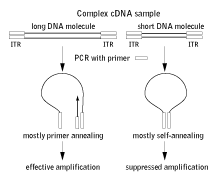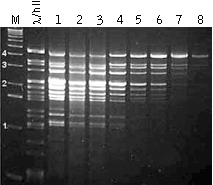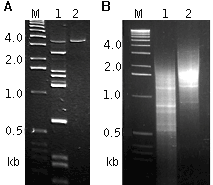
|
||||||||||
|
||||||||||
SUPPORT/Methods of nucleic acid research:

|
PCR amplification of long DNA fractionIn recent years, methods for PCR amplification of long DNA fragments have advanced significantly, especially with the invention of enzyme mixtures designed for "long and accurate PCR" (Barnes, 1994). Still, PCR tendency to amplify shorter fragments more efficiently than longer ones, most noticeably during the amplification of complex DNA mixtures containing more than one fragment, is well known. This tendency arises during the preparation of amplified full-length-enriched cDNA, during the amplification of cDNA ends, and during PCR-based genome walking. In all of these cases, the bias towards shorter DNA fragments may pose a significant problem during subsequent cloning and analysis of the PCR product. To shift the PCR preference towards longer products, we offer the PCR suppression-based method allowing amplification of long DNA fractions during PCR (Shagin et al., 1999). The PS-effect occurs when the original ITR (inverted terminal repeat) is approximately double the length of the PCR primer. In this case, intramolecular annealing is much more efficient than primer annealing and amplification becomes completely (or for very long fragments, almost completely) suppressed (Lukyanov et al., 1994; Siebert et al., 1995).
When the ITRs equal the PCR primer in length, several factors (except the length of the fragment) influence the final outcome of the competition.
Thus, by attaching ITRs to a complex DNA sample and amplifying it with a single ITR-specific primer at different concentrations, PCR preferences towards shorter products and longer products can be manipulated (Shagin et al., 1999). Using this approach it is possible to regulate the average length of the PCR product over a very wide range.
References
|
|
Copyright 2002-2023 Evrogen. All rights reserved. Evrogen JSC, 16/10 Miklukho-Maklaya str., Moscow, Russia, Tel +7(495)988-4084, Fax +7(495)988-4085, e-mail:evrogen@evrogen.com |





